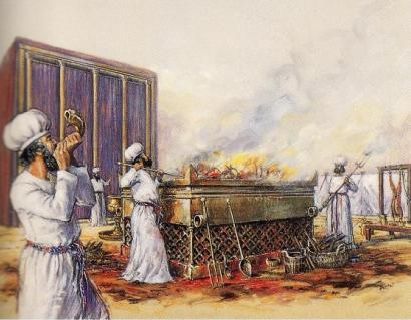
There were three entrances in the Tabernacle arrangement which include:-
- the “gate” to the “outer court” (Exodus 27:16-19).
- the “door” to the “holy place” (Exodus 26:36-37; 36:37-38).
- the “vail” to the “holy of holies.” (i.e. “Most Holy”) (Exodus 26:31-33).
All three entrances were made of the same material: a fine white woven linen with blue, purple and scarlet threads running through the material (Exodus 38:18).
All three entrances had the the same dimensions as regards their area, that is, they were all 100 square cubits — a number representing Christ Jesus:
- The gate was 20 cubits long x 5 cubits high (Exodus 38:18);
- The door and the veil were 10 x 10 cubits — SQUARE — a symbol of PERFECTION (equality on every side)!
NOTE: For the door, we do not have an explicit text for its measurements however the boards were 10 cubits high (Exodus 26:16). As to the width, we infer from the 20 cubits of Solomon’s Temple that the Tabernacle was half the size (1 Kings 6:2) — thus, 10 cubits wide. The back of the Tabernacle was defined by 6 board of a cubit and a half, so 9 cubits interior — the two sides, if each 1/2 cubit thick, would constitute 10 cubits outside dimension of the Tabernacle. If the door was sufficient to cover this, then it was 10 cubits wide.
This teaches us that the same truth seems therefore to be embodied in each of these typical curtains. The same Jesus is portrayed in each. There could be no access to God, of any kind, whether of comparatively distant worship, or of closest intimacy, but through the one door, the Lord Jesus. “I am the door” (John 10:7).
The value of 100 also “beautifully correlates to the “redemption price” of the “firstborns” which was five shekels at 20 gerahs per shekel: 100 gerahs (also representing Christ Jesus)! (Numbers 3:46,47; 18:15,16)” (Notes on the Tabernacle, page 100).
Jesus is our entry into:
- justification (the gate into the court),
- sanctification (the door into the Holy) and
- glorification (the vail into the Most Holy).
(1) THE GATE
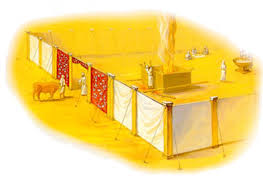
The gate was the only way into the court and represents our Lord Jesus who said of himself, “I am the door. Whoever enters through me, will be saved” (John 10:9, NIV).
“I am the way, the truth and the life. No one comes to the Father except through me” (John 14:6, NIV).
“By faith in Christ’s ransom sacrifice, represented in the Brazen altar, we enter the ‘gate’ to the ‘Court’ — the vail of unbelief and sin is passed” (Tabernacle Shadows, page 22).
The gate was wider than any of the other entrances, enabling all Israelites to enter the court. The width of the entrance shows that God makes grace available to many for “many are called but few are chosen” (Matthew 22:14).
In Exodus 40:33 we read, “And he erected the court around the tabernacle and the altar, and set up the screen of the gate of the court. So Moses finished the work.”
The root word of “gate” from Exodus 40:33 is shâʻar, shaw-ar’ and means, to split or open, reason out, estimate… and the Gesenius’ Hebrew-Chaldee Lexicon writes: “to set free… to set a price” and Jesus most certainly did “set free” every human from the curse of sin.
The gate, (as also the door and the vail) was really a “hanging.” (See Exodus 27:9, 16; 26:31,32, 36).
All three entrances were suspended by way of metal (silver or gold) hooks from the pillars which supported them (Exodus 38:19; 26:32,37). (See Study 4 of “Beauties of the Tabernacle.”) There were no curtain rods nor any other device by way of which these “hangings” could be raised up or pulled to one side.
To enter the court, and thus, in order to pass “beneath” the “hangings,” one had to lift the bottom of the curtain and stoop down and go under the curtain. This bowing to enter shows a right attitude of heart, for when we come to Christ we come humbly in need of a Saviour. The man who will not bow his knee and his heart to Christ, cannot enter in (Psalm 99:5, Ephesians 3:14, Matthew 19:24).
We can only approach Jehovah God, by recognizing Jesus’ merit and through the eyes of a New Creation mind — the mind that was also in our Lord Jesus.
There were no cherubim interwoven into this outdoor screen surrounding the court area and the gate, unlike that of the vail. (We discuss about the cherubim a little later in this Study.)
The tribe of Judah, the kingly tribe, camped outside the Eastern Gate. The name Judah means “praise,” and Jesus was descended from this tribe (Hebrews 7:14).
The Four Posts at the Gate
There were FOUR posts at the Gate (Exodus 27:16-19).
Perhaps FOUR here, could represent the four authors of the Gospels of Jesus (Matthew, Mark, Luke, John) who most conspicuously held up Christ’s character before the world and who are the instruments used to build our faith into Christ — by studying about Jesus and getting to know who he is and thus how to become like him, and learning about what he taught to likewise follow his teachings and spread the lessons to all who have a listening ear.
(2) THE DOOR

The “door” was the one entrance into the Holy (which represents the spirit begotten condition of the “little flock” class — see Study 3 of the “Beauties of the Tabernacle” series of posts on this website).
The door of the Tabernacle is of finely twisted linen (Exodus 26:36) because Jesus has completely satisfied the justice of God.
It is white to express the purity and righteousness of Jesus’ character. Jesus was the one without sin and without stain or blemish (1 Peter 1:19).
As was the gate and veil, this door was made of “blue, purple, and scarlet yarn and finely twisted linen—the work of an embroiderer” (Exodus 36:37).
The door would have been thick enough to block light and it was in the Holy Place where the golden lampstand was (which stood directly opposite the table on the south side) and it was to burn continuously both night and day (Exodus 27:20-21).
The Materials Used for the Fabric of the Sanctuary
Flax and goat’s hair were the materials used for the fabrics of the sanctuary. According to Ellicott’s Commentary for English Readers, “the flax was dyed before it was spun into thread.”
 Here is an image of two Israelite women moving the “weavers beam” forward on a large vertical loom as they make fine twisted linen.
Here is an image of two Israelite women moving the “weavers beam” forward on a large vertical loom as they make fine twisted linen.
In Exodus 35:25 we read, “And all the women that were wise hearted did spin with their hands, and brought that which they had spun, both of blue, and of purple, and of scarlet, and of fine linen. 26 And all the women whose heart stirred them up in wisdom spun goats’ hair.”
In the above verse, “wise-hearted” women refers to all who had sufficient skill. Although both men and women of ancient Egypt spun thread, spinning seems to have been done primarily by the Hebrew women. It was effected in early times by means of a wheel and spindle, with or without a distaff. (Reference: http://wol.jw.org/en/wol/d/r1/lp-e/1200000994).
Jesus Christ referred to spinning when he urged his disciples, not to be unduly anxious about clothing, but to trust in God to clothe them. Jesus said: “Mark well how the lilies grow; they neither toil nor spin; but I tell you, Not even Solomon in all his glory was arrayed as one of these.” (Luke 12:27, 28; Matthew 6:28-30).
“Of fine linen” — Rather, of white. Most of the Egyptian linen is of a yellowish white, being made from flax imperfectly blanched.
Note: It is described in the English version as the linen being wrought with the needle, or embroidered; but the word rendered “needle-work” is now believed to denote a striped or checked pattern produced by the loom. Hence the curtain of the gate and door had a blue, scarlet and purple colour appear in them in stripes or checks, instead of being wrought into figures of cherubs, as on the curtain of the vail.
The Colours of the Linen Curtains

- White
White linen was used for garments for royalty and persons of rank and has been found in the tombs of the Pharaohs. White linen always speaks of purity and righteousness:
Revelation 15:6 — “And out of the temple came the seven angels having the seven plagues, clothed in pure bright linen, and having their chests girded with golden bands.”
Revelation 3:5 — “He who overcomes shall be clothed in white garments, and I will not blot out his name from the Book of Life; but I will confess his name before My Father and before His angels.”
Revelation 19:14 — “And the armies in heaven, clothed in fine linen, white and clean, followed Him on white horses.”
The fine-twined, white linen speaks of righteousness and typifies Jesus, the Son of Man, spotless, pure, and sinless.
1 John 3:3-5 — “And everyone who has this hope in Him purifies himself, just as He is pure…and you know that He was manifested to take away our sins, and in Him there is no sin.”
- Blue
The interwoven thread of blue seems to speak the fact that Jesus remained completely loyal and true to his heavenly Father; that he faithfully maintained his righteousness and purity at all costs.
Blue is the colour of the sky without clouds and so it is also known to be a symbol of what is heavenly.
Blue is also the colour of nobility. We recognize those qualities in our Lord Jesus. He came from heaven, he then returned there as a divine soul. “He was foreknown before the foundation of the world but was made manifest in the last times for the sake of you” (1 Peter 1:20, ESV).
We read that Jesus came and being found in the appearance of a man humbled himself and became obedient unto death, even death on a cross (Philippians 2:5-11).
- Scarlet
Scarlet represents Christ’s blood shed for all — his sufferings and death on the cross. Our Lord’s loyalty and faithfulness were put to the severest tests, tests in which obedience to the will of God resulted in his sacrificial death on Calvary’s cross.
The Apostle Peter captures the thought here in saying “it was not with …. silver and gold you were redeemed… but with the precious blood of Christ“ (1 Peter 1:17-23).
It is Christ’s blood which gives life and purifies.
- Purple
Purple represents Jesus’ royalty; he was of the royal line of David, Lord of the earth, and the inheritor of all the promises of God. Our Lord Jesus became King of kings and Lord of lords since Jesus said, “All authority in heaven and on earth has been given to me” (Matthew 28:18, NIV).
Jesus is king of a kingdom not of this world (John 18:33-39).
Because of Christ’s faithfulness unto death, God indeed did highly exalt him to the royalty of the kingdom, as was prophesied many centuries in advance:
“Therefore will I divide him a portion with the great, and he shall divide the spoil with the strong; because he hath poured out his soul unto death; and he was numbered with the transgressors; and he bare the sin of many, and made intercession for the transgressors” (Isaiah 53:12).
The Five Posts at the Door
There were FIVE posts (pillars) that supported the first vail (the door) of the Holy (Exodus 26:37; Exodus 36:38). The number 5 in the Bible represents the New Creature in Christ. (See Study 3 of “Beauties of the Tabernacle”.)
These posts were constructed of shittim wood overlaid with gold, and they were set in sockets of copper — representing perfect (or justified) human nature, and therefore, the spirit-begotten condition of the church. How beautifully this reflects that the saints still in the flesh (in the Holy — representative of the “in part” condition (1 Corinthians 13:9) have their “treasure” of the Spirit (gold) in “earthen vessels” (copper) as we read of in 2 Corinthians 4:7 (ASV):
“But we have this treasure in earthen vessels, that the exceeding greatness of the power may be of God, and not from ourselves.”
(3) THE VAIL

The entrance to the Most Holy is called “the vail” (or in Hebrew, paroketh) of the Tabernacle and which the Apostle Paul in the New Testament designates “the second vail” (Hebrew 9:3).
It was only through the vail (which represents Christ’s flesh, R.4746) that one could enter into the Most Holy — the spirit-born condition of glory, honor and immortality to which the faithful over-comers of this age became heirs. (See Study 3 of “Beauties of the Tabernacle.)
For a certain period of time the door to the High Calling of the Church stands ajar during the 6000 years of permission of evil which has been allowed since 33 AD. Jesus opened up this new way of life through the veil; that is to say, his flesh—his sacrifice.
“Having therefore, brethren, boldness to enter into the holiest by the blood of Jesus, by a new and living way, which he hath consecrated for us, through the vail, that is to say, his flesh” (Hebrews 10:19, 20).
The Rending of the Vail
The rending of the Temple vail (in Jerusalem) took place at the same time as the earthquake at the moment of our Lord’s death — his crucifixion — which we read about, in Matthew 27:51 and Luke 23:45.
Interestingly, this great vail was torn, not from the bottom toward the top, as would be the expectation if it were the result of wear, but from the top to the bottom, as indicating it was a manifestation of divine power.
The rending of this curtain represents symbolically the opening of the narrow entrance way into the High Calling — an opening between heaven itself and the heavenly condition of those living in the Gospel Age (now spanning nearly 2000 years since 33 AD) by Christ through the sacrifice of his flesh.
Through that rent vail we may see into the things beyond and be ready to pass into the Most Holy (R.4746).
Passing through this second vail into the Most Holy, involves “the death of the HUMAN body” (Tabernacle Shadows, page 22).
Both the fleshly mind and fleshly body must be left behind before we can enter into the “holiest of all.” We will then be in the spirit realm, for flesh and blood cannot inherit the Kingdom of God (1 Corinthians 15:50).
True believers are represented as being associated with Jesus as priests in the Holy, (the outer apartment of the two) where they have fellowship with God through the light of the golden candlestick, through the bread of the golden table, and through the incense that we are permitted to offer on the golden altar. It is from this standpoint we can now by faith see beyond the vail — catch glimpses at least of the heavenly estate which God hath in reservation for them who love him, for the called ones according to his purpose, for the Christ, head and body (R.3371:2).
The Cherubim
Unlike the curtain for the gate and the door, the linen curtain of the vail was embroidered with cherubim, (as were the walls of the Tabernacle proper — due to cherubim embroidered on the first of the Tabernacle’s coverings). Any cherubim in the vail would presumably have been depicted in a different way than the two golden cherubim over the ark of the covenant — these being described in Exodus 25:20:-
“And the cherubims shall stretch forth their wings on high, covering the mercy seat with their wings, and their faces shall look one to another; toward the mercy seat shall the faces of the cherubims be.”
Here is one artist’s impression of what the vail pattern may have resembled:
 Cherubim being heavenly (angelic) creatures suggests that those passing beyond this vail enter into the heavenly condition — life on the spirit plane — partakers of the Divine Nature.
Cherubim being heavenly (angelic) creatures suggests that those passing beyond this vail enter into the heavenly condition — life on the spirit plane — partakers of the Divine Nature.
The ancient Jews said this later veil of the temple was as wide as four fingers, so that no one could possibly see into the Most Holy place (David Guzik).
The vail divided the Tabernacle into two, the Holy place at the front — 20 x10 cubits — and the Most Holy place that became a room 10 cubits long x 10 cubits wide x 10 cubits high.
Only the high priest was permitted to go beyond the vail. This occurred once a year, on the Day of Atonement.
When it came to moving from place to place, the vail was taken down from its hanging position and draped over the ark of the covenant (in which case, there was no “most holy” at that point, the vail defining the most holy having been taken down).
“(5) And when the camp setteth forward, Aaron shall come, and his sons, and they shall take down the covering vail, and cover the ark of testimony with it: (6) And shall put thereon the covering of badgers’ skins, and shall spread over it a cloth wholly of blue, and shall put in the staves thereof” (Numbers 4:5-6).
Hence there was sufficient means by which the Levitical priests could carry out God’s requirements of not entering the most holy nor seeing the ark of the covenant exposed and thus not inflicting death on themselves or others. For whomever would touch the ark of the covenant (other than the High Priest on the Day of Atonement) would die, such as in the case of Uzzah (Exodus 25:14-15).
Is this not a wonderful reassurance that a consecrated child of God should not fear failing in their vows of consecration until death or fear second death! Why? Because the Heavenly Father provides enough immunity against the evils that surround when, one’s fear of reverence to the Father through Christ (Proverbs 1:7) helps one seek for God’s wisdom, help and comfort in every time of need and trial (Psalm 46:1). This reverential fear of doing wrong in the eyes of God is a blessing in disguise! — helping the consecrated Christian overcome (Romans 8:37) all the testings and temptations as did our Lord Jesus when he was on earth.
“There hath no temptation taken you but such as is common to man: but God is faithful, who will not suffer you to be tempted above that ye are able; but will with the temptation also make a way to escape, that ye may be able to bear it” (1 Corinthians 10:13).
The vail (“katapetasma”) means “to hide or conceal”, hide from view the “ark of the covenant” and the “mercy seat.”
It also acted as a barrier between God and man because while we are in the flesh, in the Holy condition as the developing embryonic New Creations in Christ, God is in the Most Holy, thus the vail separates the two of us.
The FOUR POSTS at the VAIL

The FOUR posts (Exodus 26:32; 36:36) supporting the vail into the Most Holy are set in sockets of silver.
Silver is a general symbol of Truth — the knowledge of which the justified believer holds on to the righteousness of Christ. (See Study 4 of the “Beauties of the Tabernacle” Series of posts on this website, regarding details about silver.)
The posts here, represent the spirit-birth (gold) condition as an actuality (silver), where one’s treasure is obtained in the fullest sense by carrying out one’s sacrifice willingly and with great joy in the Spirit, unto death. Thus, the posts into the Most Holy no longer had sockets of copper as in at the gate and door entrance ways and this signifies that those entering the Most Holy place (Divine Realm) are no longer in the flesh.
The vail was hung from golden hooks from off the 4 posts (not from the 50 golden clasps which joined the two parts of the linen covering, although, the vail was located approximately under these clasps.) Refer to Study 8 of “Beauties of the Tabernacle.” It was probably a unified drapery on the backside of the posts.
As were the golden hooks and covering of the pillars of the holy and most holy — so are our hopes, aspirations, and calling — these all concern with things divine (Exodus 26:32-37).
The Number FOUR — In the Bible
The number four in the Bible refers to the concept of trial, testing, probation, judgment.
Thus here at the entrance of the most holy of the Tabernacle, the time of judgment of the church may be reflected in the four posts.
Here are some other examples of four in the Bible (as explained in an article titled “Symbolic Numbers” by Br. David Rice in The Herald of Christ’s Kingdom Magazine, Nov./Dec. 2004):
- At the second feeding of the multitudes by Jesus — representing the time of harvest and judgment closing the Gospel age, the number reported was four thousand.
- The forty years in the wilderness (Numbers 32:13) — representing the Gospel age period of testing, trial, development.
- The same is represented in the four hundred years of Genesis 15:13 — which describes the period of the affliction of the seed of Abraham, beginning with the mocking of Isaac, at the age of five, by Ishmael — a picture of the early affliction of the Church by the Jewish authorities and ends at the Exodus — a picture of the deliverance of God’s chosen at the end of the Gospel Age.
When multiplying these 400 years by the 360 days in a prophetic year, we yield 144,000, the number of the church in Revelation — showing the fruitage to be developed during the testing period of the Gospel age.
The different orders of magnitude of the number four (i.e. 4, 40, 400 and 4,000) also expressing the symbol.
[It is interesting to also note: “Of the dated visions of Jeremiah in chapters 25, 26, 27, 28, 29, and 36, three are dated in the fourth year of Jehoiakim, and three in the fourth year of Zedekiah — all six judgments are in a year four.
When the seven times of punishment on Israel was represented in Nebuchadnezzar’s dream, the expression “seven times” appeared four times in the narrative, and four times in the warning by Moses (Daniel 4; Leviticus 26).
These judgments were fulfilled by four Gentile kingdoms dominating Israel during the 2,520 years of their national punishment.] (Symbolic Numbers, The Herald of Christ’s Kingdom, Nov./Dec. 2004)
The colours embroidered on the white linen of the vail are the same here as for the entrance into the Holy. The presence of these three colours on the white linen vail is echoed in Revelation:
“Be thou faithful (blue) unto death (scarlet) and I will give thee a crown (purple) of life” (Revelation 2:10).
Psalm 100:2-5 (NLT)
Worship the Lord with gladness.
Come before him, singing with joy.
Acknowledge that the Lord is God!
He made us, and we are his.
We are his people, the sheep of his pasture.
Enter his gates with thanksgiving;
go into his courts with praise.
Give thanks to him and praise his name.
For the Lord is good.
His unfailing love continues forever,
and his faithfulness continues to each generation.
References
- Br. Charles T. Russell — “Tabernacle Shadows.”
[R= Reprints of the Original Watchtower and Herald of Christ’s Presence – Charles Russell]
- Br. Frey — “Notes on the Tabernacle“.
- Atwater— “The Sacred Tabernacle of the Hebrews.”
- Br. David Rice — “Symbolic Numbers,” The Herald of Christ’s Kingdom , Nov./ Dec. 2004.
Acknowledgment
Content assisted by Br. George Tabac.
Suggested Further Reading
STUDY 1: An Introduction To The Tabernacle And It’s Purpose
URL: https://biblestudentsdaily.com/2016/09/02/study-1-an-introduction-to-the-tabernacle-and-its-purpose/
STUDY 2: The Pillar of Cloud By Day And The Pillar of Smoke By Night https://biblestudentsdaily.com/2016/09/09/study-2-the-pillar-of-cloud-by-day-and-the-pillar-of-smoke-by-night/
STUDY 3: The Tabernacle Construction: The Holy and The Most Holy https://biblestudentsdaily.com/2016/09/14/study-3-the-tabernacle-construction-the-holy-the-most-holy/
STUDY 4: The Court (“Holy Place”)
https://biblestudentsdaily.com/2016/09/20/study-4-the-court-holy-place/
STUDY 5: The Camp. The Israelites.
https://biblestudentsdaily.com/2016/10/28/study-5-the-camp-the-israelites/
STUDY 6: The Levites
https://biblestudentsdaily.com/2016/11/18/study-6-the-levites/
STUDY 7: The Priests. The Day of Atonement.
https://biblestudentsdaily.com/2016/12/10/study-7-the-priests-the-day-of-atonement/
STUDY 8: The Tabernacle Coverings
https://biblestudentsdaily.com/2017/01/02/study-8-the-tabernacle-coverings/
The URL for this post:
https://biblestudentsdaily.com/2017/03/01/study-9-the-gate-the-door-the-vail/
Save
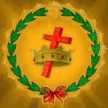





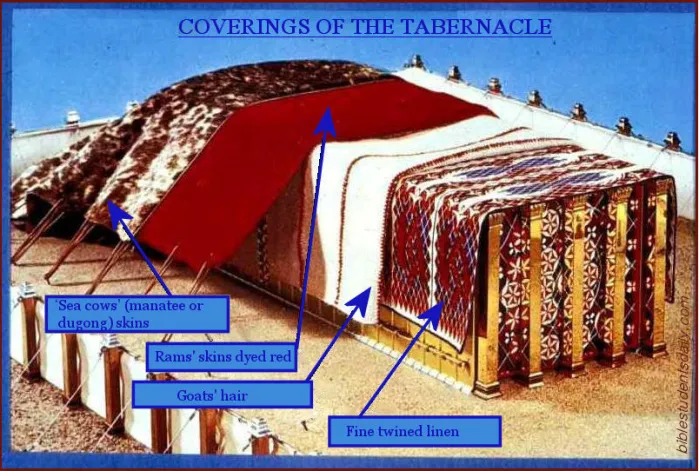













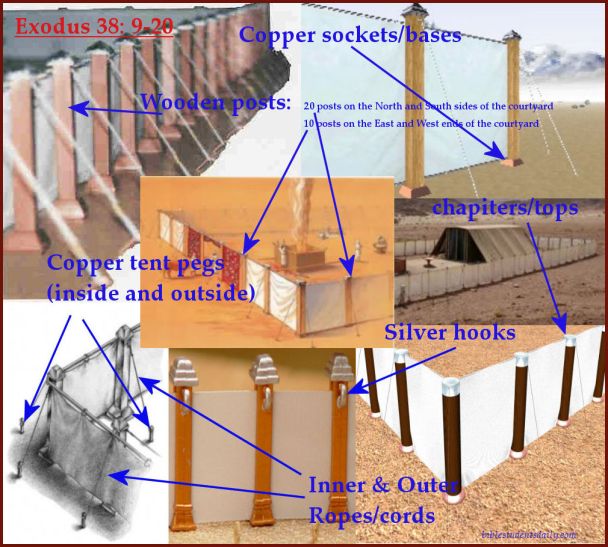
 According to the Temple Institute in Israel:
According to the Temple Institute in Israel: